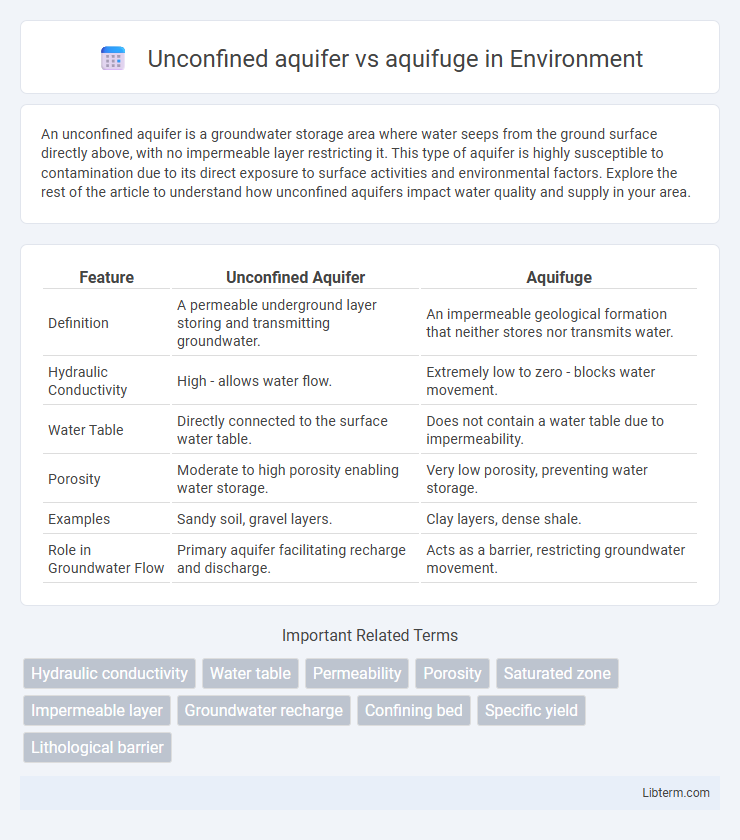An unconfined aquifer is a groundwater storage area where water seeps from the ground surface directly above, with no impermeable layer restricting it. This type of aquifer is highly susceptible to contamination due to its direct exposure to surface activities and environmental factors. Explore the rest of the article to understand how unconfined aquifers impact water quality and supply in your area.
Table of Comparison
| Feature | Unconfined Aquifer | Aquifuge |
|---|---|---|
| Definition | A permeable underground layer storing and transmitting groundwater. | An impermeable geological formation that neither stores nor transmits water. |
| Hydraulic Conductivity | High - allows water flow. | Extremely low to zero - blocks water movement. |
| Water Table | Directly connected to the surface water table. | Does not contain a water table due to impermeability. |
| Porosity | Moderate to high porosity enabling water storage. | Very low porosity, preventing water storage. |
| Examples | Sandy soil, gravel layers. | Clay layers, dense shale. |
| Role in Groundwater Flow | Primary aquifer facilitating recharge and discharge. | Acts as a barrier, restricting groundwater movement. |
Introduction to Unconfined Aquifers and Aquifuges
Unconfined aquifers are groundwater reservoirs with a permeable surface layer that allows direct recharge from precipitation, characterized by a water table that fluctuates with seasonal infiltration. Aquifuges, in contrast, are impermeable rock formations or sediments that do not transmit water, acting as barriers to groundwater flow. Understanding the distinction between unconfined aquifers and aquifuges is crucial for groundwater management and hydrogeological studies.
Definitions: Unconfined Aquifer vs Aquifuge
An unconfined aquifer is a groundwater reservoir with a permeable surface layer, allowing water to seep directly from the ground surface above, making its water table responsive to atmospheric pressure changes. An aquifuge, in contrast, is an impermeable geological formation that neither stores nor transmits significant amounts of water, acting as a barrier in hydrogeological systems. Understanding the distinct properties of unconfined aquifers and aquifuges is critical for groundwater management and hydrogeological studies.
Geological Formation and Structure
Unconfined aquifers consist of permeable geological formations such as sand or gravel where water infiltrates directly from the surface through porous soil or rock layers, allowing easy recharge. Aquifuges are geological barriers like dense clay or unfractured igneous rocks with extremely low permeability, preventing water flow and acting as impermeable layers that isolate groundwater systems. The structural difference lies in unconfined aquifers having a water table exposed to atmospheric pressure, whereas aquifuges create hydraulic separation due to their impervious nature.
Permeability and Water Transmission Capability
Unconfined aquifers exhibit high permeability, allowing water to flow freely through porous materials like sand and gravel, enabling efficient water transmission and recharge. Aquifuges possess extremely low permeability, effectively acting as barriers that prevent water movement and transmission due to their dense, impermeable composition such as clay or unfractured rock. The stark contrast in permeability between unconfined aquifers and aquifuges critically influences groundwater flow dynamics and water resource management.
Water Storage and Yield Characteristics
Unconfined aquifers store water in porous, permeable materials like sand and gravel, allowing easy recharge from surface water and high yield potential due to water availability above the water table. Aquifuges are impermeable geological formations that neither store nor transmit water, acting as barriers to groundwater flow with virtually no yield. Water storage in unconfined aquifers depends on the porosity and saturation of the material, while aquifuges exhibit negligible storage capacity and prevent water movement.
Occurrence and Distribution
Unconfined aquifers occur near the Earth's surface where permeable materials such as sand or gravel allow water to saturate the ground above an impermeable layer. Aquifuges consist of impermeable rocks or sediments like clay or shale that do not store or transmit water, effectively preventing groundwater flow. Unconfined aquifers are widely distributed in alluvial plains and river valleys, whereas aquifuges are commonly found in sedimentary basins and tectonically stable regions acting as natural barriers in groundwater systems.
Importance in Groundwater Supply
Unconfined aquifers are crucial for groundwater supply as they directly receive recharge from surface water, making them accessible and sustainable sources of fresh water. Aquifuges, characterized by impermeable layers, do not store or transmit groundwater, thus playing no role in groundwater extraction but acting as natural barriers that influence aquifer recharge and flow. Understanding the distinction between unconfined aquifers and aquifuges is essential for effective groundwater management and sustainable water resource planning.
Methods of Identification and Mapping
Unconfined aquifers are typically identified through surface water infiltration tests, water table measurements, and geophysical methods like electrical resistivity, which map permeable layers allowing free groundwater movement. Aquifuges, characterized by their impermeability, are distinguished using core sampling and seismic surveys that reveal non-porous strata preventing water flow. Accurate mapping of unconfined aquifers and aquifuges involves integrating hydrogeological data with geographic information systems (GIS) to delineate groundwater boundaries and impermeable barriers.
Environmental and Engineering Implications
Unconfined aquifers allow water to infiltrate directly from the surface, making them highly susceptible to contamination from surface pollutants and requiring careful land use management to protect water quality. Aquifuges, with their impermeable nature, prevent water flow and act as natural barriers, influencing groundwater flow patterns and necessitating engineered solutions for water extraction and contamination risk mitigation. Engineering projects must consider the hydraulic properties of unconfined aquifers for sustainable water supply and the impermeability of aquifuges to avoid unintended groundwater disruptions and environmental degradation.
Summary Table: Key Differences Between Unconfined Aquifer and Aquifuge
Unconfined aquifers contain permeable materials that allow water to flow freely and have a water table exposed to the atmosphere, while aquifuges are impermeable layers that prevent water movement. The key contrasts include the presence of groundwater storage in unconfined aquifers versus the absence of groundwater in aquifuges, and the ability of unconfined aquifers to recharge through surface infiltration compared to the impermeable nature of aquifuges. These differences impact groundwater availability, recharge potential, and hydrogeological behavior in subsurface environments.
Unconfined aquifer Infographic

 libterm.com
libterm.com